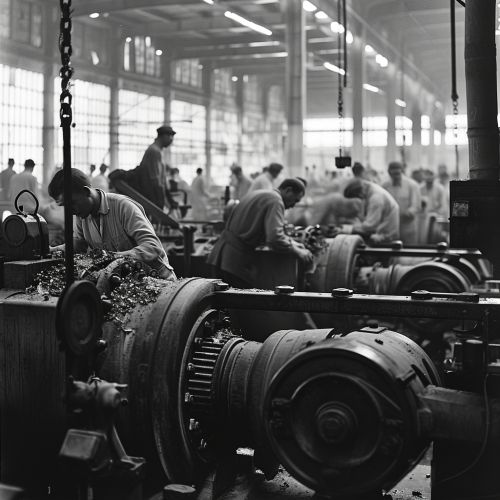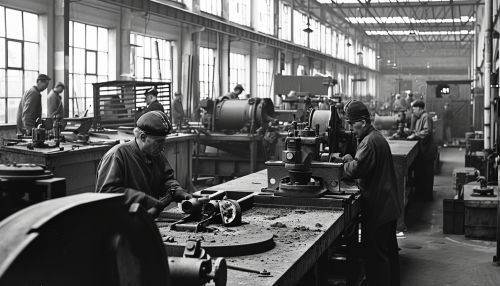Five-Year Economic Plans of the Soviet Union
Introduction
The Five-Year Economic Plans of the Soviet Union were a series of nation-wide centralized economic plans in the Soviet Union, created and implemented by the state planning committee, Gosplan. These plans were developed every five years and were responsible for setting the direction of the Soviet economy from 1928 until the dissolution of the Soviet Union in 1991.
First Five-Year Plan (1928-1932)
The First Five-Year Plan, which was introduced in 1928, marked the beginning of the period of rapid industrialization in the Soviet Union. The plan aimed to transform the Soviet Union from a predominantly agrarian society into a major industrial power. The main focus of this plan was on heavy industry, with a particular emphasis on coal, iron, and steel production. The plan also sought to increase the production of machinery and tractors to support the mechanization of agriculture.


Second Five-Year Plan (1933-1937)
The Second Five-Year Plan continued the focus on heavy industry but also included the development of infrastructure and the expansion of the Soviet Union's transportation network. This plan also saw the introduction of the Stakhanovite movement, a campaign to increase worker productivity.
Third Five-Year Plan (1938-1941)
The Third Five-Year Plan was disrupted by the outbreak of World War II. The plan had initially focused on consumer goods, but the war necessitated a shift towards the production of military equipment and armaments. The plan was officially abandoned in 1941 when the Soviet Union was invaded by Nazi Germany.
Fourth Five-Year Plan (1946-1950)
The Fourth Five-Year Plan was primarily focused on the reconstruction of the Soviet Union following World War II. The plan aimed to restore industrial and agricultural production to pre-war levels and to rebuild the cities and infrastructure that had been destroyed during the war.
Fifth Five-Year Plan (1951-1955)
The Fifth Five-Year Plan marked a return to the emphasis on heavy industry, with a particular focus on the production of energy, steel, and machinery. The plan also sought to increase the production of consumer goods and to improve living standards.
Sixth Five-Year Plan (1956-1960)
The Sixth Five-Year Plan saw a shift in focus towards the development of the chemical industry and the production of synthetic materials. The plan also aimed to increase agricultural production through the expansion of irrigated land and the introduction of new farming techniques.
Seventh Five-Year Plan (1961-1965)
The Seventh Five-Year Plan focused on the development of the Soviet Union's technological and scientific capabilities. The plan aimed to increase the production of high-technology goods and to improve the efficiency of industrial production.
Eighth Five-Year Plan (1966-1970)
The Eighth Five-Year Plan saw a continuation of the focus on technological development, with a particular emphasis on the electronics industry. The plan also sought to increase the production of consumer goods and to improve living standards.
Ninth Five-Year Plan (1971-1975)
The Ninth Five-Year Plan focused on the development of the energy sector, with a particular emphasis on the production of oil and gas. The plan also aimed to increase the production of consumer goods and to improve living standards.
Tenth Five-Year Plan (1976-1980)
The Tenth Five-Year Plan saw a shift in focus towards the development of the service sector and the improvement of the Soviet Union's infrastructure. The plan also sought to increase the production of consumer goods and to improve living standards.
Eleventh Five-Year Plan (1981-1985)
The Eleventh Five-Year Plan focused on the development of the Soviet Union's technological and scientific capabilities. The plan aimed to increase the production of high-technology goods and to improve the efficiency of industrial production.
Twelfth Five-Year Plan (1986-1990)
The Twelfth Five-Year Plan was the last of the Soviet Union's five-year plans. The plan focused on the development of the Soviet Union's technological and scientific capabilities, with a particular emphasis on the electronics industry. The plan also sought to increase the production of consumer goods and to improve living standards.
Conclusion
The Five-Year Economic Plans of the Soviet Union played a significant role in shaping the Soviet economy throughout the 20th century. While the plans were often criticized for their emphasis on heavy industry and their neglect of consumer goods, they were instrumental in transforming the Soviet Union into a major industrial power.
